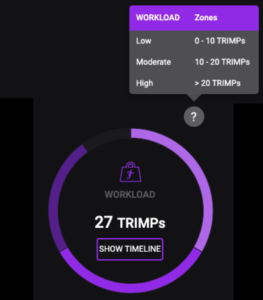Introduction:
Injury has become an epidemic among youth and collegiate sports in North America and as participation increases in youth sport, so too do the number of injuries. As recently as 2014, it was estimated that 1.5 million high-school and collegiate athletes are injured annually. While intuitively we may attribute many of these injuries to trauma or contact to the affected limb or body segment, it is less commonly known that up to 70% of all soft-tissue injury can occur in the absence of contact!
Soft-tissue injuries are largely multi-factorial and may be reliant on a combination of both uncontrollable and controllable risk factors. Research has shown, one controllable risk factor is to monitor training load to note potential fatigue and prevent overtraining. An effective way to mitigate this risk factor is through Load Management.
Concepts:
Broadly speaking, load refers to both the measure of the external stimuli and the body’s internal (or physiological) response to those stimuli. The stimuli can be, but are not limited to, training. These stimuli can also include, homework, recreational activities, stress, work, etc.
Load can also be broken into two categories: External Workload and Internal Workload.
Workload, as presented by Beyond Pulse, is a measure of External workload. Thus, by definition, our Workload metric is a measure of the external stimuli applied to an athlete during a session. Broadly speaking, Workload is a product of both session intensity (Number of Sprints, Percentage at High Speed, Speed Zones) and volume (Distance) performed by an athlete during his/her session. Simply put,
Note: HR is not factored into its calculation.
Workload is measured in units called TRIMPs. A ‘TRIMP’ is an abbreviation of ‘Training Impulses,’ and can be thought of as just a unit. If I asked you, ‘What is a Volt,’ your answer would likely be, ‘ a unit of electricity.’ Similarly, TRIMP is just simply a unit of Workload.

Figure 1. Workload dial and scale as presented on your coach and/or player session summary screen.
As noted in the stats table within the Workload Timeline of the Beyond Pulse Session Summary (Figure 2), Workload is categorized by intensity to be either low, medium, high or max intensity. This is not to be confused with the zones listed above!

Figure 2. Overall Session workload broken into low, medium, high and max intensity zones
This is a critical component to understanding and using Workload in your training. Though Workload is accumulated during all types of movements while wearing your Beyond Pulse Smart-belt, it is important to understand the relationship between the intensity zones and the overall Workload of your session. Simply put, Workload is accumulated more quickly as intensity is increased. Meaning that a 10-minute activity at low intensity will result in a lower Workload than a 10-minute activity at Moderate Intensity and likewise for High and Max Intensities. However, remember that workload is also a function of volume (distance and time). Meaning that, a session with low intensity session may still have a high Workload since the amount of distance covered and/or the length of the practice also affect your overall session Workload. Workload Management
Stay tuned. More to follow!
Key Definitions:
Soft-tissue injury – Injuries to the muscles, ligaments, and/or tendons such as a sprain, tear, or contusion.
Training Load – A measure of related stressors to the athlete.
Load Management – Management of a combination of sport and non-sport related stressors to the athlete.
Workload – an objective measure of the external stimuli applied to the athlete during his/her session.
Volume – a measure of the total amount of activity an athlete performs. For Soccer, measures of volume include distance and time.
TRIMPs – an abbreviation of training impulses, TRIMPs are the units of measure for Workload.

 ENG
ENG































